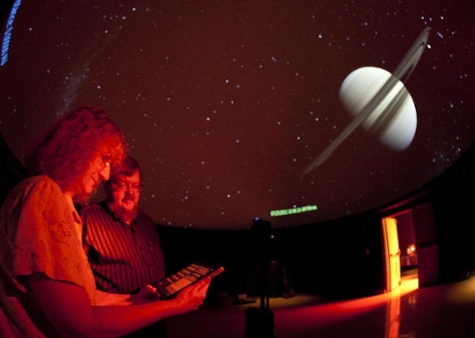September 30, 2014
14-290
Rebecca J. James, Graduate Assistant
Planetarium Presents October Skies Oct. 3

|
|
The Valdosta State University Planetarium will present October Skies, the first program of its 2014-2015 public outreach season, on Friday, Oct. 3. Pictured are Dr. Martha Leake and Dr. Kenneth Rumstay of the Department of Physics, Astronomy, and Geosciences in the planetarium. |
VALDOSTA — The Valdosta State University Planetarium will present October Skies, the first program of its 2014-2015 public outreach season, on Friday, Oct. 3.
Shows will begin at 7 p.m., 8 p.m., and 9 p.m. and last 40 to 50 minutes Admission is free of charge. Seating is limited to 47 people per show, and tickets will be distributed beginning at 6 p.m. on a first-come, first-served basis. The rooftop observatory will be open before and after each show, weather permitting.
Dr. Martha Leake, a professor in VSU’s Department of Physics, Astronomy, and Geosciences, will lead the program as she “reveals Valdosta’s beautiful night sky.” She earned a doctorate in planetary sciences from the University of Arizona and teaches astronomy, physical science, some geology and physics, and interdisciplinary courses.
“This October brings a wealth of exciting astronomical events to the backyard observer — two eclipses, two comets, two new spacecraft at Mars, three new crew members at the ISS, and a meteor shower,” noted Dr. Kenneth Rumstay, a professor in VSU’s Department of Physics, Astronomy, and Geosciences.
“During October, the planet Mars creeps through Scorpius, past the bright red star Antares, [meaning] the Rival of Mars. Slower Saturn has been left behind in Libra, and before the end of the month, Jupiter will grace our late evening skies. Before sunrise on Oct. 8 the full moon will enter … Earth’s shadow, resulting in a total lunar eclipse. Two weeks later, on Oct. 23, we may catch the beginning of a partial solar eclipse.”
“The European Rosetta mission,” he continued, “has rendezvoused with Comet 67P/Churyumov-Gerasimenko and is planning to deploy a lander, which will sample cometary material on Nov. 12. Weeks earlier, on Oct. 19, Comet Siding-Spring will pass close to Mars, brushing the planet with its tail of dust and gas. Astronomers anxiously wait to see what will happen to our fleet of Martian probes. Finally, recent deliveries of people and supplies to the International Space Station have filled out the crew to six. Let’s wave to them on Oct. 3 when they pass over at 8:37 p.m.”
Located on the third floor of Nevins Hall, the VSU Planetarium underwent extensive renovations during the summer of 2011 and now includes a Digitarium Kappa digital projector, which can reproduce the night sky as seen from anywhere on Earth or from the surface of any object in the solar system, at any time in history, past or future. This technology is the first of its kind in the world.
Public outreach shows are appropriate for children ages 5 and up.
Contact the Department of Physics, Astronomy, and Geosciences at (229) 333-5752 for more information.
On the Web:
http://www.valdosta.edu/colleges/arts-sciences/physics-astronomy-geosciences/welcome.php
Newsroom
- Office of Communications Powell Hall West, Suite 1120
-
Mailing Address
1500 N. Patterson St.
Valdosta, GA 31698 - General VSU Information
- Phone: 229.333.5800
- Office of Communications
- Phone: 229.333.2163
- Phone: 229.333.5983